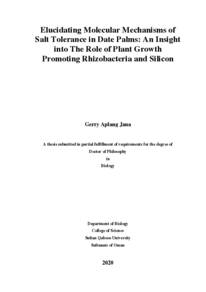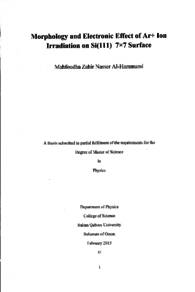Document
Elucidating molecular mechanisms of salt tolerance in date palms : an insight into the role of plant growth promoting rhizobacteria and silicon.
Publisher
Sultan Qaboos University.
Gregorian
2020
Language
English
English abstract
The global agriculture sector is under tremendous pressure to meet the growing food
demand accelerated by increasing population. This is worsened with the rising
phenomenon of soil salinization of arable land attributable to global warming. Therefore,
there is a need to develop sustainable agricultural methods to enhance the salinity
tolerance of crops. The date palm (Phoenix dactylifera L.) is the most important crop,
with over 250 varieties, cultivated in the arid regions of the Middle East and North Africa.
In Oman, there are about 250 varieties of date palm cultivated occupying 50% of the total
agricultural land and comprising about 80% of the entire fruit trees grown in the country.
However, various factors such as high evaporation, lack of precipitation, and the
indiscriminate use of underground water have led to an increase in soil salinization, which
in turn has hampered the date production. Therefore, the aim of this thesis is to study the
potential use of Plant Growth Promoting Rhizobacteria (PGPR) and silicon in enhancing
the salinity tolerance of date palm. We identified an Achromobacter xylosoxidans SQU1 (SQU-1) strain and a microbial volatile organic compounds (mVOC) producing
Enterobacter cloacae SQU-2 (SQU-2) strain which were able to enhance the growth of
Arabidopsis seedlings under salinity stress in vitro. The genomes of these strains were
further sequenced to identify the potential genes that may be involved in plant growth
promotion. Analysis of the genome sequence of SQU-1 resulted in the identification of
the 1-aminocyclopropane-1-carboxylate deaminase gene, which encodes for the enzyme
that degrades 1-aminocyclopropane-1-carboxylate, the main precursor for the
vii
biosynthesis of stress hormone ethylene. Also, other plant growth-promoting gene
clusters including those that code for enzymes producing siderophore and antibiotics.
Whereas from the genome of SQU-2 the gene clusters relating to the synthesis of growthpromoting mVOC 2,3-butanediol and acetoin along with the other growth-promoting
genes were identified. Further, the use of 5 mM Na2SiO3 as a soluble form of silicon was
able to enhance salt tolerance mechanism of the date palm seedlings. Therefore, to gain
further insight into how silicon can confer salinity tolerance to the date palm seedlings a
global untagged metabolite profiling using the hydrophilic interaction liquid
chromatography (HILIC) and reverse-phase liquid chromatography (RPLC) was
performed. The analysis resulted in the identification of 1101 significantly (p ≤ 0.05)
accumulated metabolites in the leaf and root tissues in response to salinity and silicon
treatment of which 836 and 839 metabolites were identified in the leaf and root tissues,
respectively. Among them 345 metabolites were shared between both the tissue types
under the different conditions. Further analyses of the different accumulated metabolites
suggested that silicon may enhance antioxidative and detoxification of various toxins
including, cytotoxic metabolite methylglyoxal (MG) via glyoxalase I, II and III system,
the detoxification and redox balance through the gamma-glutamyl cycle and enhanced
hydrogen cyanide detoxification. From this study, three potential gene families were
further investigated for their roles in salinity tolerance mechanisms in date palm,
including the six glutathione peroxidase (PdGPX) genes, five Glyoxalase I (PdGLX1)
genes and four Glyoxalase III (PdDJ-1) genes. Their expression profile quantified by
real-time PCR (qPCR) revealed that the genes are expressed in a tissue-specific manner
in response to various environmental cues. Further, heterologous overexpression of the
different PdGPX, PdGLX1, and PdDJ-1 genes in BL21 (DE3) showed enhanced growth
under salinity (250 mM NaCl), oxidative (5 mM H2O2) and exogenous MG (0.5 mM MG)
viii
stress conditions. In addition, the genes were able to complement the loss of function of
the H2O2- sensitive GPX3D, MG hypersensitive GLO1 and oxidative sensitive Hsp31D
knock out yeast mutants respectively. In addition, the heterologous overexpression of a
PdDJ-1C in Arabidopsis resulted in the production of non-viable albino phenotype,
thereby suggesting that the PdDJ-1C plays an important role in chloroplast
development.
Member of
Resource URL
Category
Theses and Dissertations


